In the post Liverpool (again) I updated matters to 2014 but there have been more trips and posts since.
On 29th December, 2015, I made a day trip to Liverpool which is described in the post Merseyside in December.
On 29th December, 2016, I made a day trip to Liverpool which spawned a three-part post:-
Return to Merseyside (Part 1)With my surveys incomplete, I returned on 4th February 2017, resulting in the post Exploring Liverpool's former South Docks.
Return to Merseyside (Part 2)
Return to Merseyside (Part 3)
At the beginning of January, 2018 I travelled to Liverpool again and that trip is described in this post.
Our weather had been cold and often windy, frosty or wet. I consulted the forecasts but eventually plumped for the first Saturday in 2018 and left my home at eight o'clock to catch our first bus of the day which goes to Penkridge, where I hoped to catch a train. The main roads from Brewood to Penkridge aren't usually too bad but the bus takes a circuitous route through Bishop's Wood, Wheaton Aston, Lapley and Whiston, involving narrow lanes and sharp, unsighted bends. Despite offering a transport service to all these communities, I was the only passenger from Brewood and just one young man joined us at Wheaton Aston. To keep anywhere near time, the bus had to be driven quite hard so I found it quite an exciting journey. The young passenger and I got off at Penkridge Medical Centre and I showed him the footpath under the railway and through the churchyard to the station.
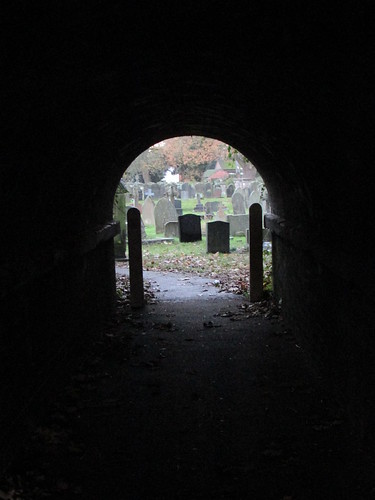
South Staffordshire: Penkridge, pedestrian tunnel under railway with churchyard in the background.
My new friend was travelling to Birmingham and, by dashing up the stairs to platform 1, he just caught a train which arrived as we approached. I had time to negotiate with the touch-screen ticket machine which was running new software, presumably because the Train Operating Company at Penkridge has recently changed.
The previous 'London Midland' franchise was taken over by West Midlands Trains on 10th December 2017. There's a useful Wikipedia article here. The new company is operating two 'brands'. Trains within the West Midlands form the 'West Midlands Trains' brand whilst 'long-distance' trains to London and Liverpool form the 'London Northwestern Railway' brand. Although I'd seen a picture of a West Midlands Trains trainset in their new livery, the trains I saw during the day all retained their old 'London Midland' livery.
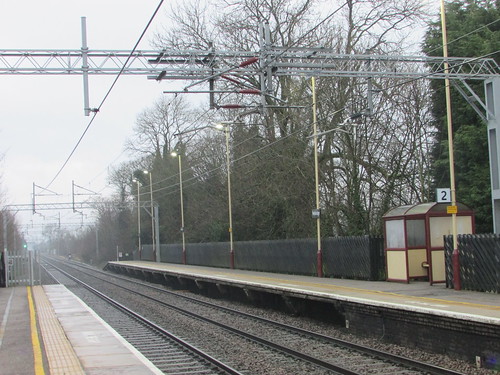
Trip to Merseyside 6-Jan-2018: A gloomy Penkridge Station, looking towards Stafford.
The journey to Liverpool Lime Street was on-time. When I saw that our arrival was into one of the low-numbered platforms usually reserved for local trains, I remembered that Liverpool Lime Street is in the throes of an Upgrade Programme which will create one new platform and lengthen two others. There's a little more about this in the section 'Liverpool Lime Street Upgrade'. I purchased an 'All-Zones 1-day Saveaway' giving unlimited bus, train and ferry use in Merseyside and descended to Liverpool Lime Street Low Level to catch a Merseyrail service two stops to James Street.
A few minutes later, I was emerging into sunshine at James Street and, although it wasn't exactly warm, the walk to the Museum of Liverpool was pleasant enough. I'm secretary of the Old Locomotive Committee (there are lots of posts about the 'Old Locomotive' in question - 'Lion' here) so, when in Liverpool, I like to check-up on the Museum's 'star exhibit'. All was normal (although I'm never very happy to see a steam locomotive 'stuffed and mounted').

'Lion' Exhibit, Museum of Liverpool.
A display case in the foyer now covers the Liverpool tram system. I was impressed by the detailed model of a 1936 tram as that's the design of tram I remember seeing on my early trips to Liverpool.
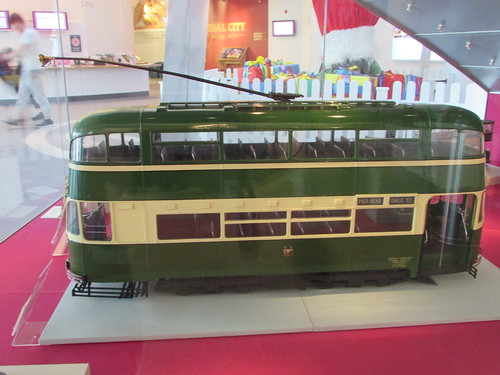
Tramways Exhibit, Museum of Liverpool with model of 1936 'Green Goddess' tram.
This year, I was surprised to find the waterfront between the Museum and the Ferry Landing Stage hosting a Fun Fair, with a few hardy ride operators open for business - the wind was noticeably keener near the water.

Liverpool Waterfront with Fun Fair.
I was probably even more surprised by the appearance of the iconic Liver Building and its clock. The clock face facing the museum was missing both hands: that facing the river was working but 20 minutes fast!
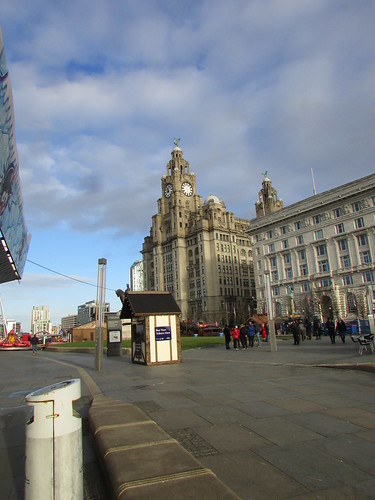
Trip to Merseyside 6-Jan-2018: Liverpool Waterfront.
It's become a tradition for me to take the 'Ferry cross the Mersey', so I boarded 'Snowdrop' on the 11 o'clock sailing still, I'm afraid, in her 'Dazzle' livery. I've complained before about Sir Peter Blake's interpretation of 'Dazzle Painting' which bears only a slight relationship to the actual livery applied to many ships in World War I (see the post here).
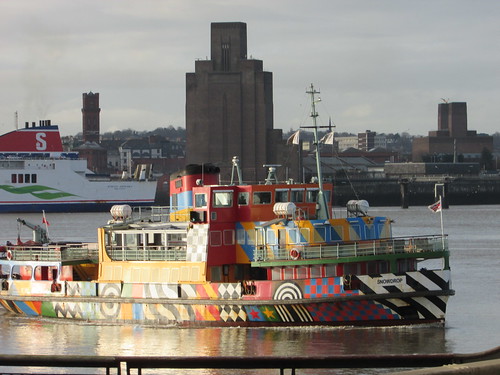
Trip to Merseyside 6-Jan-2018: Mersey Ferry 'Snowdrop' approaching Pierhead in bright sunshine.
Of course, I positioned myself on the open promenade deck near the bow, despite the sharp wind. I never tire of the views of the the old docks and modern shipping. As we slipped away from Pierhead, we were preceded by 'Ro-Ro' (Roll-on, Roll-off) ferry 'Stena Mersey' heading for Belfast which joined a procession of departing ships.
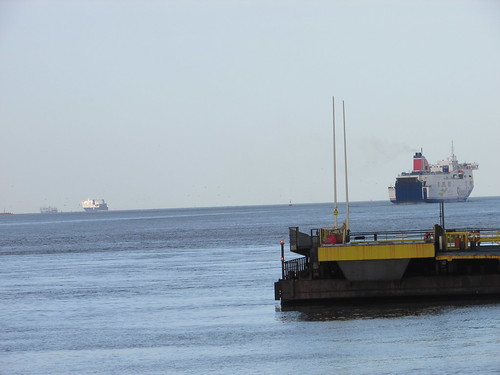
Trip to Merseyside 6-Jan-2018: Three ships leaving Liverpool just after 11.00 a.m. (L-R) Unidentified, 'Seatruck' 'Ro-Ro' ferry to Dublin, 'Stena Mersey' 'Ro-Ro' ferry to Belfast.
Whereas the gangway at Pierhead is now hydraulically operated, at Seacombe (and Woodside) gangways remain counterbalanced and manually operated. The 'shore party' at each location is now one man to handle the bow mooring line, the gangway and the gate on the landing stage which allows passengers onto the ferry. On the ferry, two deckhands appear to handle all activities. In the tricky waters of the Mersey, safe ferry docking depends upon good co-ordination between the Captain, the deckhands and the shore man. According to the state of the tide, the ferry docks either facing upstream or facing downstream.
We docked at Seacombe Landing stage, landed a handful of passengers and boarded others.

Trip to Merseyside 6-Jan-2018: Docking at Seacombe Landing Stage.
'Snowdrop' then headed upstream, passing 'Ro-Ro' ferry 'Stena Precision' moored at Twelve Quays Ferry Terminal and made a loop to starboard so as to dock with the ferry facing downstream.

Trip to Merseyside 6-Jan-2018: Birkenhead Woodside Landing Stage.
A section of gunwhale on either side of the ship, fore and aft has a sliding section which, when pushed open, allows the gangway to drop onto the main deck. A sign warns passengers 'In the interest of safety please stand behind the brass line until gangway is lowered' and a (rather tarnished) brass strip is set in the decking. I found this a delightful survivor from more innocent, less Health and Safety obsessed times.
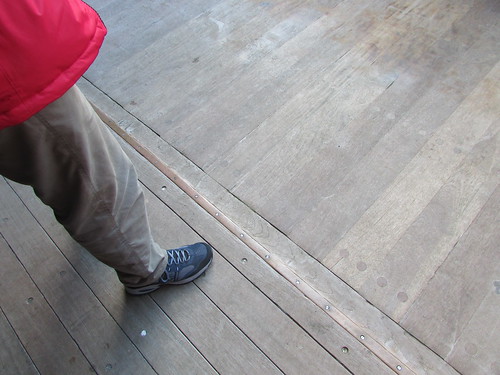
Trip to Merseyside 6-Jan-2018: Passengers obediently stand behind the brass line, waiting to disembark.
I made my way ashore and walked to Hamilton Square station, with its impressive tower, listed Grade II. Pevsner comments:-
Station. c1886. By G.E.Grayson. Brick and terracotta. Italianate style. Hamilton Street elevation has hydraulic tower on angle, and pedimented central block of booking hall, with triple round-arched windows in apex and inserted lower openings. Deep cornice band of terracotta panels. Glazed roof to booking hall. Glazed canopy projects from this block and from the tower. 3-bay range to left with louvred windows to right and doorway to left, possibly generator house. 3 paired round-headed windows above, and a row of oculi over. Terracotta cornice and mouldings to openings. Prominent 4-stage tower with round arched windows in lower stage with clusterd shafts. Triple round-arched windows above, then single round-arched windows and ribbed panelled band with paired segmentally arched windows, some now blocked. Cornice above, then giant segmentally-arched recesses housing 2 tiers of mullioned and transomed windows with enriched terracotta detail. Machicolated embattled parapet then high round arched recesses with paired windows and oculi. Clustered shafts at angles form pinnacles. Balustraded parapet and small lead fleche. 3 bay 3-storeyed return elevation to Bridge Street with continuous arcading at each level. Interior of booking hall has glazed tiled walls and queen post and collar roof with wrought iron ties. The station was built as part of the Mersey railway and Mersey rail tunnel, which opened in 1886. The engineers were James Brunlees and Charles Douglas Fox.The underground platforms have always been accessed by lifts which were originally hydraulically-operated (the tower housed the hydraulic accumulator) but are now electric. The station was refurbished in 2014-2015.
(The Buildings of England: Pevsner N and Hubbard E: Cheshire: Harmondsworth: 1971-).
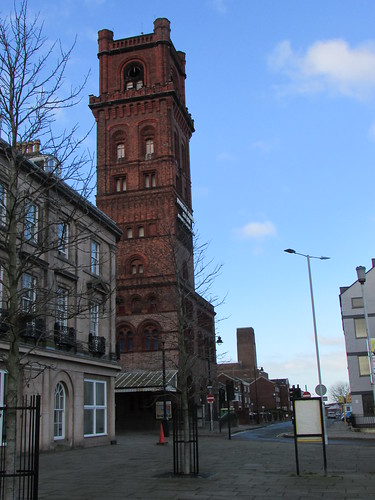
Trip to Merseyside 6-Jan-2018: Hamilton Square Station.
I took a New Brighton Train from Platform 3. The current trains are Class 507 and 508/1 3-car units built between 1978 and 1980. Although these trainsets are elderly, an Alstom refurbishment programme between 2002 and 2005 has improved the "passenger experience". However, in 2016, Merseytravel placed an order with Swiss train builder Stadler which will replace the entire fleet with Class 777 METRO 4-car sets by 2021.
Passing through Birkenhead, I noticed the top of the superstructure of a navy ship in the Cammell Laird Yard (which is discussed in the section Bidston Graving Dock of my post here). On my return home, I identified the ship as 'RFA Ford Austin' using the Ship AIS page here.
I was soon at New Brighton Station. Merseyrail make up for the fairly spartan trains by having stations which are staffed, warm, well-lit, provided with clean, working toilets and, usually, a shop or refreshment facilities.
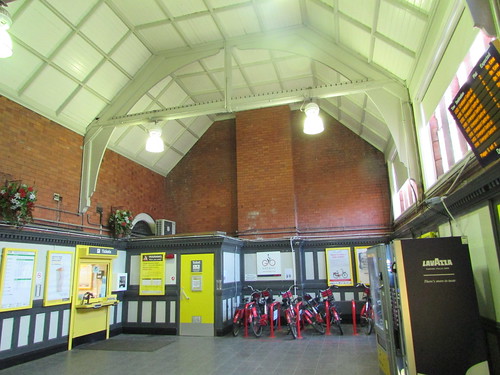
Trip to Merseyside 6-Jan-2018: Booking Hall at New Brighton Station.
I set off on foot down Victoria Road towards the estuary, pausing at Victoria Road Fish and Chips for a take-away portion of excellent chips which lasted me to the Promenade. The massive, red-painted container cranes at the new deep-water port at Seaforth called 'Liverpool 2' dominate the view across the river. I briefly discussed the building of this facility, to handle post-Panamax vessels, in the post Notes on Liverpool and its Docks and I think I first saw these cranes in December 2016, as reported here.

Trip to Merseyside 6-Jan-2018, view from New Brighton Promenade across river: (L:) Panamanian-registered bulk carrier 'Lord Nelson' (28,653 DWT) heads out to sea, (R:) Liberian-registered container ship 'Songa Antofagasta' (35,534 DWT) moored at 'Liverpool 2'.
Although the new quay is open, there have been problems with the unexpected appearance of a sink-hole in the North Quay and locals have grumbled that they haven't seen many super-sized container ships yet. Needless to say, a Peel Ports spokesman remained confident for the future of this facility. The modern Floral Pavilion lies on the landward side of the promenade.

Trip to Merseyside 6-Jan-2018: Floral Pavilion Theatre, Promenade, New Brighton.
Before I made my way back to the railway station, I watched 'Oramalia' heading out to sea, following 'Lord Nelson'.
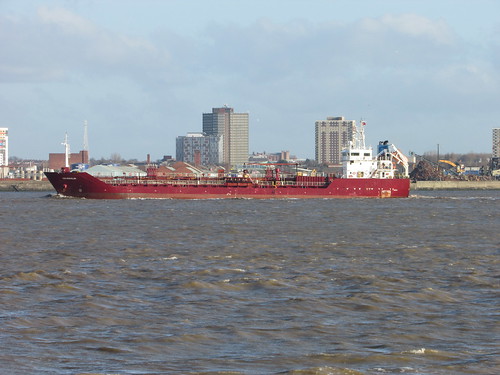
Trip to Merseyside 6-Jan-2018: Viewed from New Brighton Promenade, Gibraltar-registered oil/chemical tanker 'Oramalia' (6,863 DWT) heads out to sea.
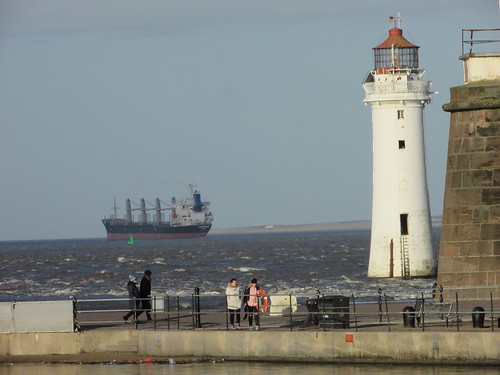
Trip to Merseyside 6-Jan-2018: Panamanian-registered bulk carrier 'Lord Nelson' 28,653 DWT heads out to sea with the former New Brighton Lighthouse on the right.
I arrived at the station in time to see a train just leaving. I spent the short time waiting for the next service taking pictures around the station.
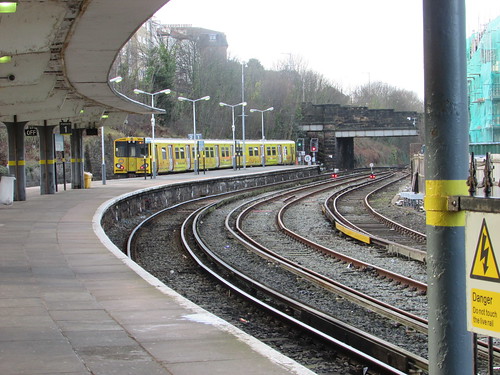
Trip to Merseyside 6-Jan-2018: Class 508 'Merseyrail' service leaving New Brighton station.
The train returned me quickly to the City and I alighted at Liverpool Lime Street station where escalators took me to the main line concourse. I'd originally intended to explore a little more but I was tired from the walking and the temptation of a Wolverhampton-bound train standing in the new platform 8 proved too great so, after a quick photograph at the platform end, I boarded the train home.
Liverpool Lime Street station Upgrade
When complete, the Upgrade with give Lime Street one extra platform and two lengthened platforms. Originally, the wide island platform 7/8 carried a carriage road allowing taxis and other vehicles direct access to trains. This was a common feature at important stations when I was growing up but appears to have fallen out of favour (although on my 2009 visit to Howrah station in Kolkata I was delighted to find the carriage road still in use). For some years, the carriage road at Lime Street had been used for various buildings, including the Virgin Trains First Class Lounge since the Virgin services to London used platform 7. All these buildings have been demolished (the Virgin First Class Lounge has been relocated on the concourse). Eliminating the space used by the carriage road has allowed the island platform to be narrowed, leaving room for an additional track and platform which will be the new platform 7, increasing subsequent platform numbers by one.
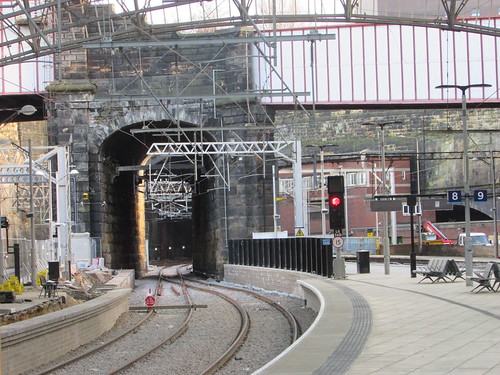
Trip to Merseyside 6-Jan-2018: Liverpool Lime Street Station. L: New platform 7 under construction, R: New platform 8 in use.
My train departed from the new platform 8 but work on the new platform 7 was still under way. There's a colourful (but inaccurate) computer-generated publicity image showing the final arrangement reproduced below.

Computer image of Liverpool Lime Street after Upgrade.
Postscript
Although I returned home from Liverpool Lime Street without incident, the following day Network Rail closed the station to all trains for an estimated two days because of the discovery of dangerous corrosion in an Overhead Line structure affecting all lines.
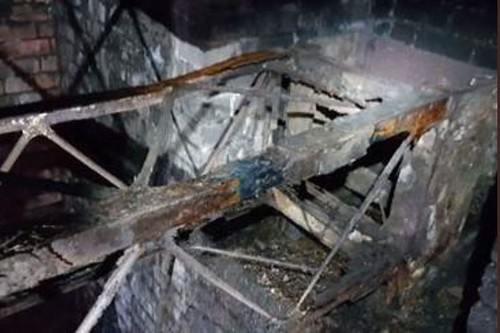
Corroded OLE gantry on approach to Lime Street pictured by RMT Union.
This is not the only case of Network Rail's shortcomings affecting Lime Street. Less than a year earlier, in February 2017, the station was closed for a week following partial collapse of the stone-built retaining wall in Edge Hill Cutting. In November 2017 the Rail Accident Inspection Branch published its report on the incident which you can find 17/2017.
Related posts on other websites
Although the links worked at the time this post was published, changes made by that website's owner may 'break' the link.
West Midlands Trains.
RAIB Report 17/2017.
Related posts on this website
As I comment above, 'Merseyside' is a recurring theme in this blog. Your can find all my posts about Merseyside here.
Posts on the Old Locomotive Committe are here.
My photograph albums
Where necessary, clicking on an image above will display an 'uncropped' view or, alternately, pictures may be selected, viewed or downloaded, in various sizes, from the album covering this trip:-
Trip to Merseyside.
